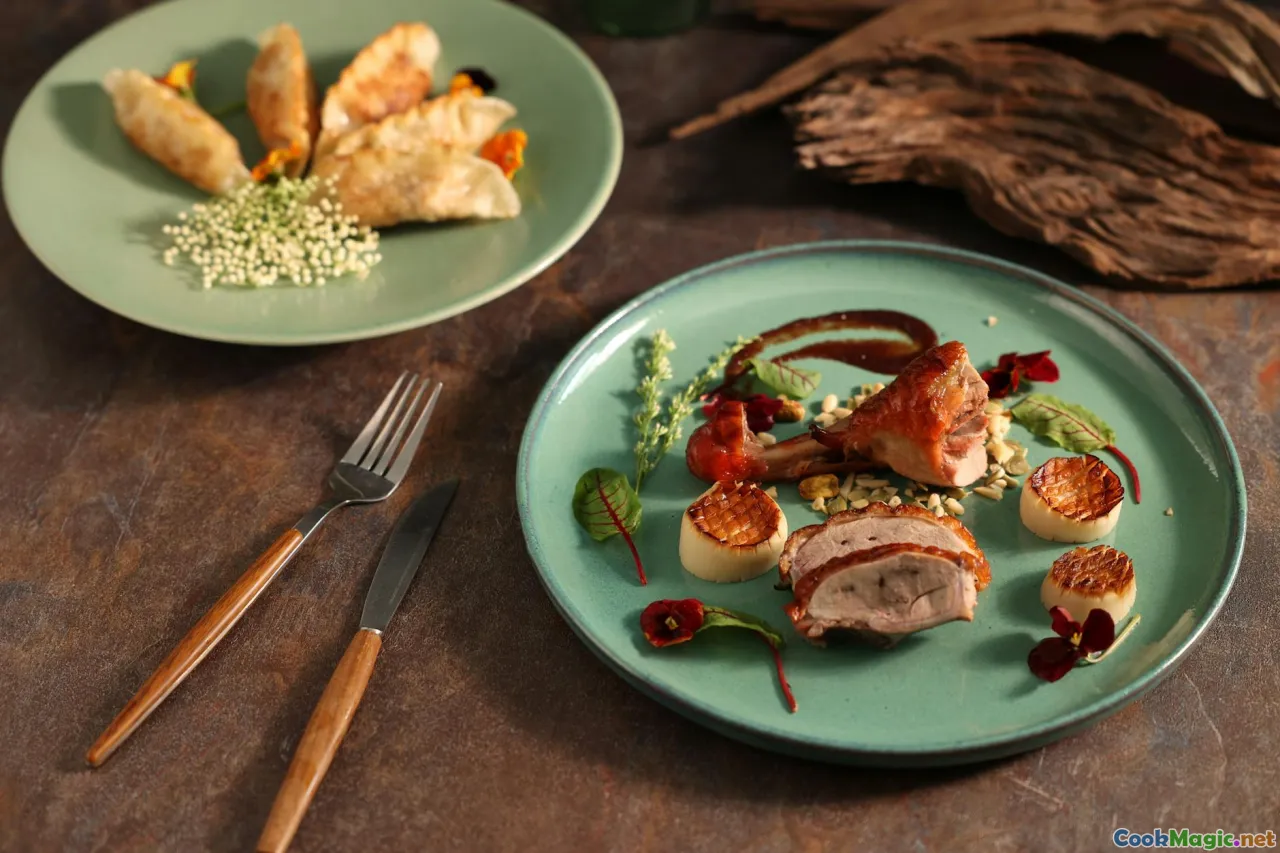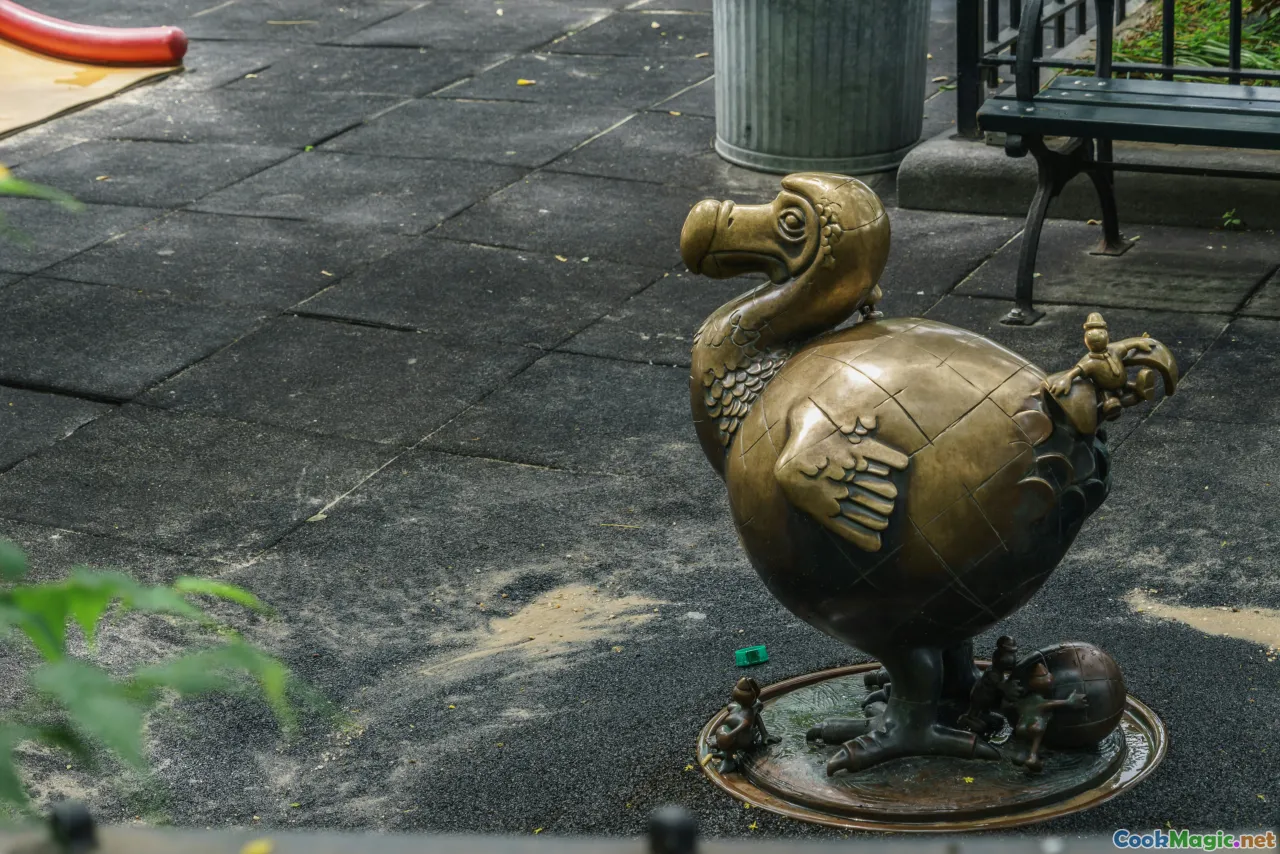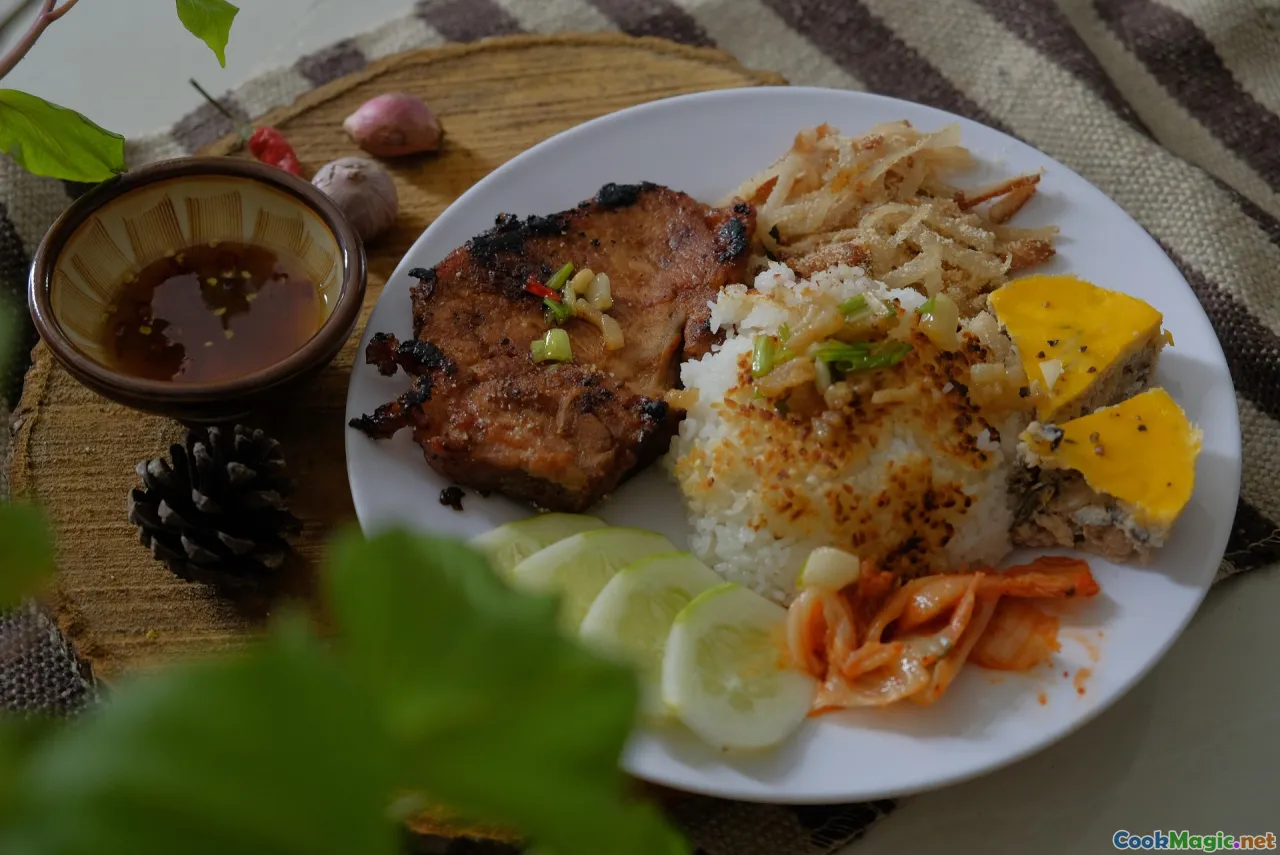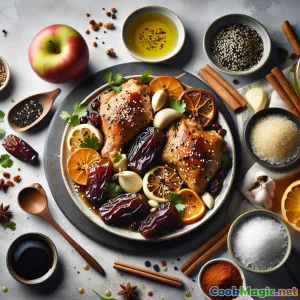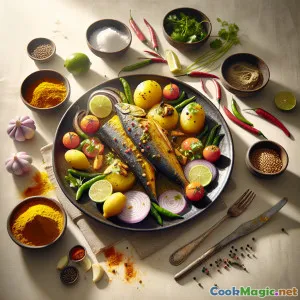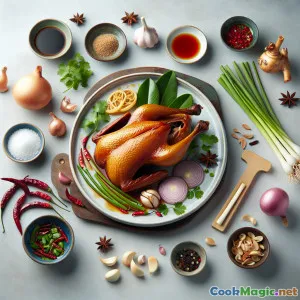
新鮮なガランガルとともにジューシーなサパ蒸し鴨
(Juicy Sa Pa Duck Steamed with Fresh Galangal)
(0 レビュー)材料
-
1.2 kg 鴨
(Organic preferred, cleaned and quartered)
-
60 grams フレッシュなガランガルの根
(Peeled and sliced into thin coins)
-
3 units レモングラスの stalks
(Bruised and cut into 5 cm pieces)
-
3 units シャロット
(Peeled, finely sliced)
-
4 units ニンニクの cloves
(潰した)
-
1 unit フレッシュチリ
(Thinly sliced, add more to taste)
-
2 tbsp 魚醤
-
1.5 tsp 塩
-
1 tsp 挽きブラックペッパー
-
2 tbsp 米酒
(Preferably Vietnamese or sake)
-
2 units 青ねぎ
(刻んだ、飾り用)
-
20 grams フレッシュコリアンダー
(飾り用)
(Organic preferred, cleaned and quartered)
(Peeled and sliced into thin coins)
(Bruised and cut into 5 cm pieces)
(Peeled, finely sliced)
(潰した)
(Thinly sliced, add more to taste)
(Preferably Vietnamese or sake)
(刻んだ、飾り用)
(飾り用)
栄養
- 分量: 4
- 1人分の量: 1皿(250g)
- Calories: 420 kcal
- Carbohydrates: 7 g
- Protein: 36 g
- Fat: 28 g
- Fiber: 2 g
- Sugar: 2 g
- Sodium: 900 mg
- Cholesterol: 120 mg
- Calcium: 60 mg
- Iron: 4 mg
作り方
-
1 - Prep the Duck:
Pat the duck pieces dry. Optionally, rub with a little salt and rice wine to remove any gamey odors. Rinse and pat dry again.
-
2 - Marinate:
In a large bowl, combine the duck, sliced galangal, half the lemongrass, shallots, garlic, salt, pepper, fish sauce, and chili if using. Mix well, cover, and let marinate for at least 20 minutes.
-
3 - Prepare the Steamer:
Layer the bottom of the steamer with the remaining lemongrass pieces. This adds flavor and prevents sticking.
-
4 - Steam the Duck:
Place marinated duck onto the lemongrass bed in the steamer. Scatter the remaining marinade, galangal, and aromatics over the duck. Cover and steam over boiling water for 50-60 minutes, or until the duck is very tender and juices run clear.
-
5 - Garnish & Serve:
Let rest for a few minutes, then slice and arrange on a large plate. Garnish with chopped spring onion and fresh coriander. Serve hot with steamed rice and a dipping bowl of fish sauce.
Pat the duck pieces dry. Optionally, rub with a little salt and rice wine to remove any gamey odors. Rinse and pat dry again.
In a large bowl, combine the duck, sliced galangal, half the lemongrass, shallots, garlic, salt, pepper, fish sauce, and chili if using. Mix well, cover, and let marinate for at least 20 minutes.
Layer the bottom of the steamer with the remaining lemongrass pieces. This adds flavor and prevents sticking.
Place marinated duck onto the lemongrass bed in the steamer. Scatter the remaining marinade, galangal, and aromatics over the duck. Cover and steam over boiling water for 50-60 minutes, or until the duck is very tender and juices run clear.
Let rest for a few minutes, then slice and arrange on a large plate. Garnish with chopped spring onion and fresh coriander. Serve hot with steamed rice and a dipping bowl of fish sauce.
新鮮なガランガルとともにジューシーなサパ蒸し鴨 :の詳細
Galangal Steamed Sa Pa Duck: Tradition & Flavor in Every Bite
Galangal Steamed Sa Pa Duck, or as it’s known in local contexts, Vịt Hấp Riềng (galangal in Vietnamese is ‘riềng’), is a luxurious and wholesome dish deeply rooted in the culinary heritage of Sa Pa, a mountainous region nestled in northern Vietnam. Famed for its cool, mist-shrouded climate and cultural tapestry of ethnic minority groups, Sa Pa offers unique produce and cooking traditions—none more celebrated than this intensely fragrant, tender duck specialty.
A Brief History & Tradition
Sa Pa, at a crossroads of the H'mong, Dao, and Tay cultures, harnessed steaming not just for delicate flavors, but also to preserve the tender succulence of rare mountain poultry. Ducks reared in crisp mountain air feed on wild plants and streams, making their flavor more robust and their meat surprisingly lean. Using galangal—an aromatic relative of ginger but punchier and more peppery—paired with fresh lemongrass resulted in a cooking style that captured the essence of local herbs and the quality protein on hand.
When visitors wandered into local homes and inns, Vịt Hấp Riềng would often mark special occasions: births, harvests, Tet holidays (Vietnamese New Year), or simply as a show of hospitality and respect. Each family adds its twist, sometimes with additions like wild pepper leaf or local rice spirit.
The Flavor Profile
What sets this dish apart is its heady aroma and pristine taste. The steaming process locks moisture in; aromatics infuse the bird—with assertive notes from galangal cutting through richness, while lemongrass delivers citrus vibrance. Shallots and garlic lend sweetness and depth, while a background note of fish sauce embodies that classic Vietnamese "umami." The skin, having steamed atop a bed of lemongrass, stays delicate but flavorful, with chunks of galangal almost acting like an edible perfume pot.
Tips, Substitutions & Variations
- Duck: If Sa Pa duck is unavailable, choose a good-quality, free-range duck. Never skip patting it dry; moisture can make steaming less effective.
- Galangal: Essential for authenticity. You may substitute ginger in a pinch but expect a subtler and less resiny kick.
- Rice Wine: Not crucial but brings out aromas and naturally tenderizes. Japanese sake works well.
- Herbs: Spring onion and coriander brighten up each serving. Mint or shiso work also.
- Steaming Method: A bamboo steamer imparts a delicate “woody” note, but modern metal steamers work, too. Place lemongrass generously at the base to avoid sticking and elevate aroma.
- Serving: Generally, this dish is eaten with plain steamed rice—allowing the flavorful juices to be absorbed by the grains. In local custom, a spiritous rice wine chaser may follow each bite.
Health & Balance
Sa Pa-style cooking employs steaming not just for taste, but as a gentle, health-forward technique. It preserves nutrients and keeps calorie counts on the lean side compared to frying or braising. Duck meat balances rich protein and iron content, while galangal and lemongrass both bring anti-inflammatory and digestive-supporting properties prized in Vietnamese natural medicine.
Unique Aspects & Cultural Significance
No two Galangal Steamed Sa Pa Ducks are quite alike. Farmhouse-to-townhouse, adaptations reflect frugal inventiveness with maximum flavor. This dish elegantly accommodates communal meals: one bird, aromatically flavored and served whole, signals togetherness and respect. Passing slices of meat amid shared bowls feels as at home in a rural cottage as alongside polished tourist restaurant plates.
Most meaningfully, Galangal Steamed Sa Pa Duck puts the spotlight on mountain-fresh ingredients and Vietnamese know-how. It’s a lesson in balance and restraint, generosity, history, and, above all, hospitality—from the first deep inhale to that last, satisfying bite.

